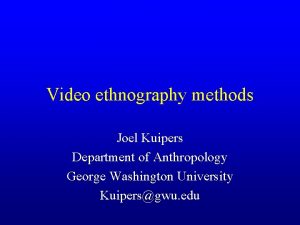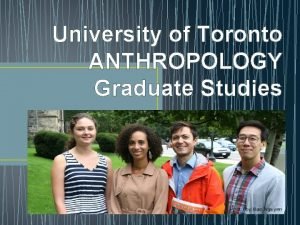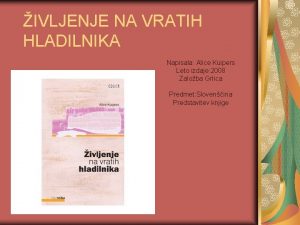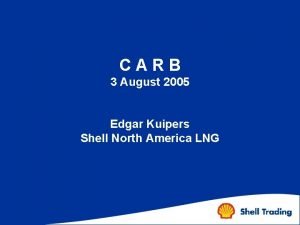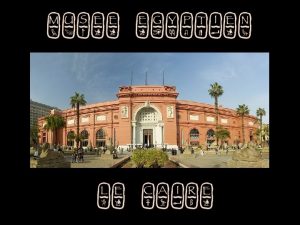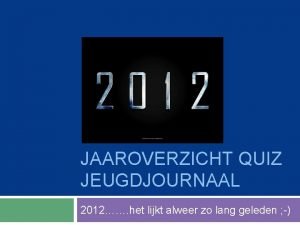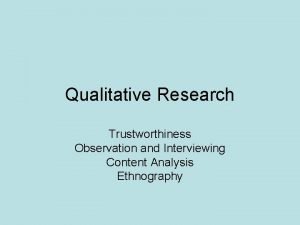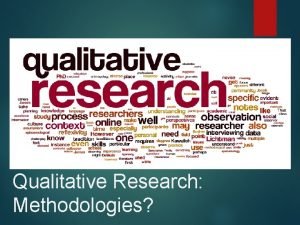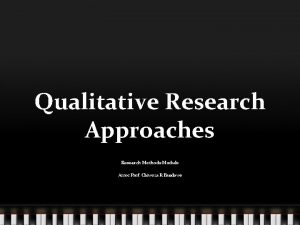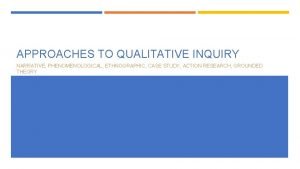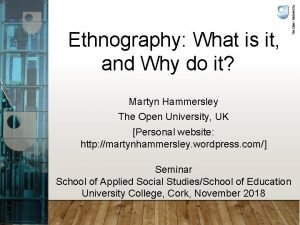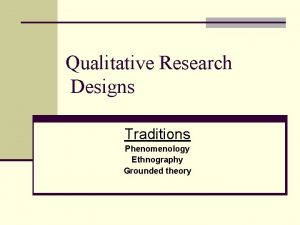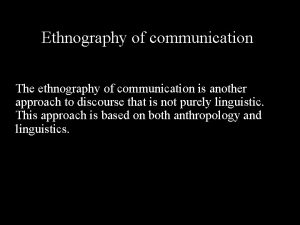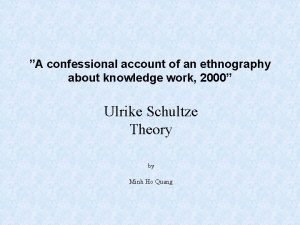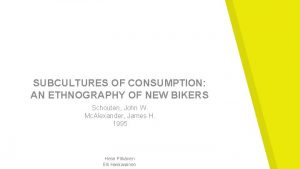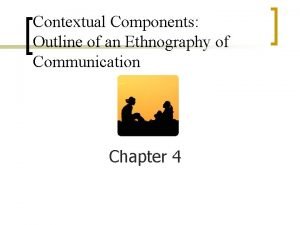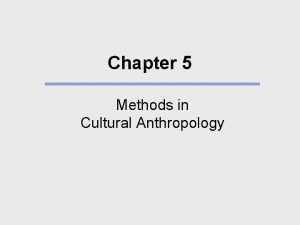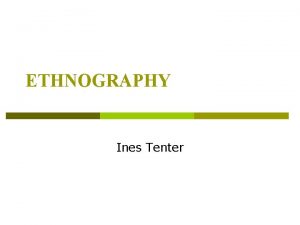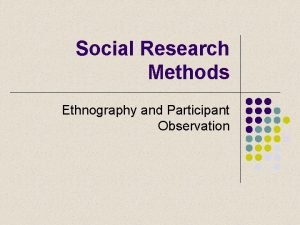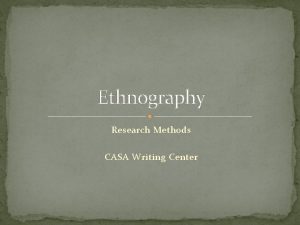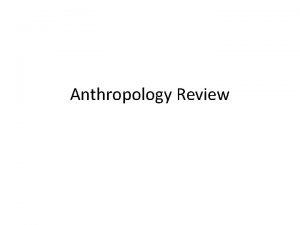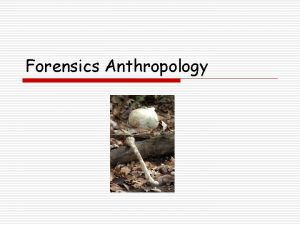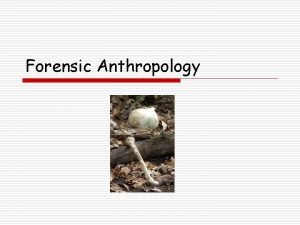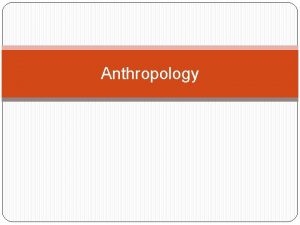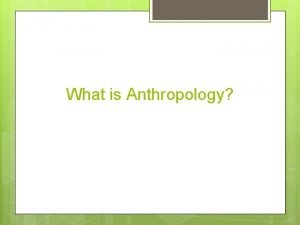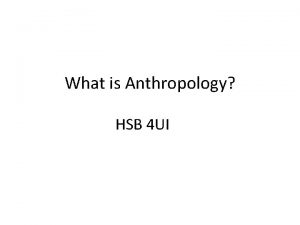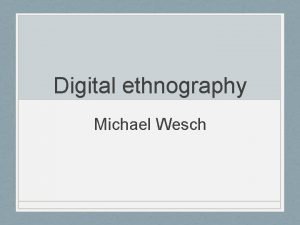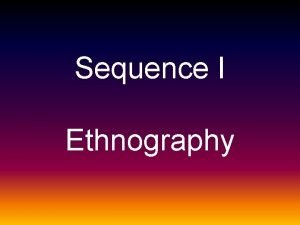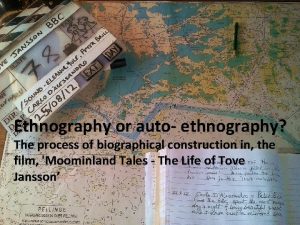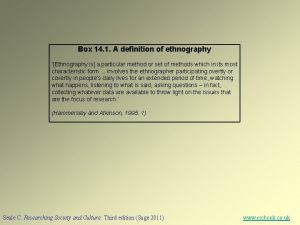Video ethnography methods Joel Kuipers Department of Anthropology



















- Slides: 19

Video ethnography methods Joel Kuipers Department of Anthropology George Washington University Kuipers@gwu. edu

Research design: A Video Ethnography • Ethnography: detailed description of the communicative system of a culture and the culturally defined situations in which relevant distinctions in that system occur (Conklin 1962) • During one class period, a linguistically, ethnically, and academically heterogeneous lab table of four 8 th-grade children was filmed every day for approximately 8 weeks, including 3 weeks prior to the implementation of the HR curriculum. • Another camera filmed a different table each day for comparison purposes.

Research design: A Video Ethnography • Focused on Chemistry That Applies, highly rated by AAAS Project 2061. • Teachers volunteered their classrooms; offered a camcorder in exchange • The students’ activities were recorded and digitized; lessons were transcribed analyzed using Atlas. ti software • Year 1 - 68 hours of video a corpus of over 1800 pages of on-line searchable transcriptions linked to video

Research design • How do HR curricula function? Holistically, human communicative activities consist of pragmatic, syntactic, and semantic functions (Morris 1938; Hymes 1980; Engestrom et al 1999). • Many aspects of these functions can be captured with codes that describe: – Pragmatic Interactional features operationalized as “clarification practices” (cf. 2061 #1 Convey lesson purpose) – Syntactic and Linguistic features operationalized as use of scientific register - (cf. 2061 # 4 Use scientific ideas and terminology) – Semantic, referential features operationalized as object manipulation - (cf. 2061 #3 Direct experience with relevant phenomena).

Gathering data: practicalities • The students’ speech was recorded with a Canon GL 2 camera and a pair of Audio Technica boundary microphones placed on the table. • Microphones were connected to the camera via a radio transmitter. • Video tapes were digitized using MPEG-1 codec using both hardware encoder card (Primeview), and software encoder (Pinnacle v. 9). • Backups made on CD ROMs • Primary data placed on a central 1 TB RAID, accessed by 9 computers connected via a 100 Mbs switch.

Software analysis • Videos linked to transcription via Atlas. ti, a qualitative database program • Using the quotation function of Atlas, each video was divided exhaustively into contiguous time “segments” corresponding roughly to a turn at talk • Each “quotation” was transcribed into the Atlas COMMENT area using the transcription conventions in Edwards 1992 Talking Data. • Completed transcriptions were saved as Primary Documents, hyperlinked to video via a supplementary software program, “Filesort” • Keyword searches on the transcript produce corresponding spot on the video

Atlas. ti video analysis • Transcriptions on the left • Codings on the right (hyperlinked to video)

Searching the database • Hyperlinked corpus permits complex Boolean searches by student, word, phrase, lesson, many other dimensions • Part of speech tagger - Connexor • Concordance - Wordsmith - OUP

Presentations • MPEG videos edited and titled using “native” MPEG editors (Honestech and Clipview)

Some difficult issues • While video provides in-depth analysis of particular scenes, how representative is it? – Our sample vs. corpus measure • Quantification of ethnographic data: how can we measure interrater reliability? – Different raters coded the same transcripts for “clarification” “object manipulation” and “scientific term use” – reached approximately 80% agreement.

Ethical issues • Ethical issues – Protecting identities of children –use of color negative, pseudonyms – Keeping control over circulation of videos – use of streaming technology – Informed consent – parents of all children signed release forms granting use of videos in professional contexts.

Ethnographic Approach: theoretical framework and research question • Learning takes place in sociohistorical contexts – Vygotsky 1979 • These contexts consist of acts of participation in culturally defined activities – Lave and Wenger 1991; Wenger 1998 • Research question: How does a highly rated science curriculum unit function in the context of diverse middle school classrooms?

An example. . • Experiment to demonstrate the conservation of matter by weighing vinegar and baking soda mixed and unmixed in both a closed and open environment

Philip weighs the bottle • To explore benchmark concepts of conservation of matter, Philip directly manipulates a relevant object (2061 #4) • Sean requests clarification reflecting lesson purpose (2061 #1) • Natalie offers peer remedy (2061 #1) • Sean uses scientific register (‘before weight’) as part of a scientific register (2061 #3) Natalie Philip Sean

• Patterns of Clarification A clarification episode is an interactional sequence initiated by a trouble marker and followed by one or more remedies. A trouble marker is a verbal or non-verbal conventional form that signals a discontinuity in communication. A remedy is a verbal or non-verbal response to a trouble marker. Sean often accesses benchmark ideas by expressing conceptual trouble • Philip expresses benchmark idea by remedying the “trouble” of others in group contexts •

Scientific register as STU • Given Sean’s low overall level of participation, his percentage of STU is high as a way of expressing the benchmark ideas • Gloria and Natalie have lowest STU at table, but average for class

Object Manipulation • While Natalie and Gloria speak the most (1044 x and 973 x), they manipulate objects less than Philip or Sean; • Sean and Philip engage manually more often, but speak less.

Conclusions • The students interpreted the curriculum by using scientific terms, manipulating objects and engaging in clarification practices, exhibiting both variation amongst themselves and functional contrasts in context. • CTA offered a variety of avenues to approach the benchmark concept

Contact info: • Joel Kuipers, Professor, Department of Anthropology, George Washington University, kuipers@gwu. edu • www. gwu. edu/~scale-up • Dr. Gail Viechnicki, Post Doctoral Researcher, Anthropology, GWU, gbv@gwu. edu • Emily F. Bruno, Research Assistant ekfugate@gwu. edu
 Joel kuipers
Joel kuipers University of toronto anthropology masters
University of toronto anthropology masters Alice kuipers
Alice kuipers Edgar kuipers
Edgar kuipers Antoine kuipers
Antoine kuipers Andre kuipers
Andre kuipers Sensory ethnography
Sensory ethnography Ethnography topics
Ethnography topics Ethnography and case study compare
Ethnography and case study compare Ethnography strengths and weaknesses
Ethnography strengths and weaknesses Ethnography template
Ethnography template Phenomenology vs ethnography
Phenomenology vs ethnography Ethnography
Ethnography Phenomenology and ethnography
Phenomenology and ethnography Narrative ethnography definition
Narrative ethnography definition Instrumentalities in communication
Instrumentalities in communication Confessional ethnography
Confessional ethnography Subcultures of consumption
Subcultures of consumption Ethnography outline
Ethnography outline Ethnography participant observation
Ethnography participant observation
